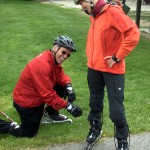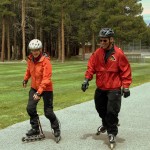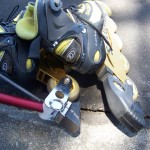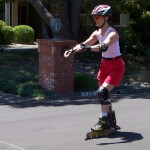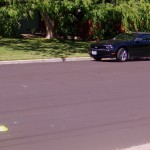Archive for the ‘Skating’ Category
Saturday, August 10th, 2013
WARNING TO DECENT PEOPLE! Read no further. This piece is not for you. There are f-bombs all over this piece ‘coz that’s the way I f-bombin’ talk. [And retelling such an adventure almost requires it to capture the intensity of feelings! — Liz]
by George Merkert
I was psyched when I read Scott Peer’s mail asking whether I wanted to head up to the Eastern Sierra for a little skate with him and a couple of his other downhill skater pals.
All I could think was, “Hell yes. I’ll skate it for sure.” Read more... (3961 words, 2 images, estimated 15:51 mins reading time)
Tags:extreme downhill skating, george merkert, gravity master brake, guest blogger
Posted in Adventures, Sk8 Links, Skating | Comments Closed
Sunday, August 4th, 2013
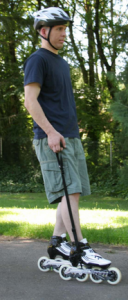 The Flex Brake is a new approach to inline braking and speed control currently seeking funding through “Kick Starter.” When they reach a certain number of pre-orders they’ll be able to go into production. Meanwhile, an adventurous few are already testing early prototypes.
The Flex Brake is a new approach to inline braking and speed control currently seeking funding through “Kick Starter.” When they reach a certain number of pre-orders they’ll be able to go into production. Meanwhile, an adventurous few are already testing early prototypes.
I took a look at the Flex Brake video and Kickstarter page and then noncommittally shared links with my skate network. I avoided voicing my concerns about the design because I am not a tester and I did not want to negatively impact the company’s prospects for success. Read more... (452 words, 2 images, estimated 1:48 mins reading time)
Posted in Gear, Skating | Comments Closed
Tuesday, June 4th, 2013
Posted in Gear, Skating | Comments Closed
Thursday, May 30th, 2013
Following is a guest article submitted by Daniel Stratton of the U.K., where skating is hugely popular in all its forms.
What it is and Where it Originated
Roller derby is now a popular contact sport with over 1,250 amateur leagues in various countries in the world. Basically, it’s played by two opposing teams that are composed of five members each. Both teams are placed in the same track and they must roller skate in the same direction. The object of the game is to score points by lapping any member of the opposing team and this is usually done by a jammer. The jammer or the scoring player is designated by the team and it’s commonly the strongest player in the group. Every team member must protect and assist their jammer while preventing the opposing jammer from scoring. This sport requires good planning in terms of offense and defense strategies. Read more... (797 words, 1 image, estimated 3:11 mins reading time)
Posted in Gear, Skating | Comments Closed
Sunday, May 19th, 2013

After 20 years as a formal publication and the voice of Get Rolling, the quarterly Get Rolling Orbit Inline Skating Newsletter is going into quiet retirement. Read more... (334 words, 4 images, estimated 1:20 mins reading time)
What does this mean?
- There will be no more mailing list and no more email announcements.
- People who follow Get Rolling with Liz Miller on Facebook or Sk8teacher on Twitter will continue to have access to my posts there.
- Orbit archives prior to May 2010 (when I started using WordPress) will still be available on GetRolling.com.
Posted in Liz's Journal, Skating | Comments Closed
Sunday, May 19th, 2013
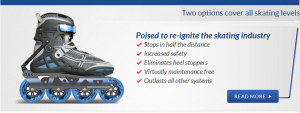
The motto just above Alex Bellehumeur’s email contact information says:
Will it so & so it Will
Anybody who thinks a few years of delay is going to discourage this accomplished inventor is wrong. The About the Inventor page on his new web site clarifies further, “…he has a passion for solving product-related challenges, currently holding 12 patents, with 3 more pending.” Read more... (210 words, 1 image, estimated 50 secs reading time)
Posted in Gear, Skating | Comments Closed
Sunday, May 19th, 2013
Some experts believe it takes ten thousand hours of practice to achieve mastery in any particular area. That means if you average ten hours of skating a week (assuming other time commitments to family and a job), achieving world-class skills would take about 20 years. The studies showed it wasn’t innate talent that brought success to the now-famous people, it was lots and lots of hours doing something they were passionate about.
Whether or not you’re aiming to become a world-class skater, it is smart to tailor your hours of practice to achieve improvements sooner rather than later. Below I share tips that have helped my students over the years, and that continue to help me when I’m learning something new (always). Read more... (478 words, 1 image, estimated 1:55 mins reading time)
Posted in Fitness, Skating | Comments Closed
Monday, April 15th, 2013
Based on the article “Plumb Perfect,” written for the May/June 2004 edition of Yoga Journal by Roger Cole, PhD, a certified yoga instructor and research scientist.
I like to encourage skaters at all levels to practice one-foot balance poses to improve agility, coordination and confidence. Such practice also delivers better control over a constantly shifting center of gravity during the motions of skating so we can become more efficient with each stroke. This article discusses how alignment, strength and attention affect your balance practice. Read more... (570 words, 3 images, estimated 2:17 mins reading time)
Posted in Fitness, Skating | Comments Closed
Friday, April 5th, 2013
“Frankly,” he confided, “I’ve been doing this sport for so long, I can’t really empathize with her learning issues.” The truth comes out.
The instructor’s perspective counts
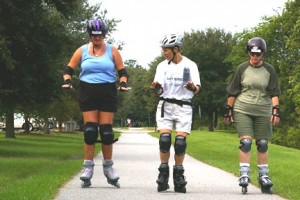
Beginners want to be on a real trail ASAP
What a difference the teacher’s level of empathy makes to the beginner who is at the bottom of the skills ladder, where each stance, each movement must be learned from scratch in the proper sequence to build one skill at a time …to just feel safe skating on a local trail …to dance through slalom cones. Read more... (507 words, 1 image, estimated 2:02 mins reading time)
Posted in Skating | 1 Comment »
Friday, March 8th, 2013
One fine day while skating in farm country, I found myself flying over a freshly plowed field of dirt clods at high speed. The cow grate across the trail had been a big surprise as I raced to catch up with another skater! That was my most memorable test of hitting the rough in a Scissors Coast. Fortunately, my helmet and an instinctive tuck and roll made this a non-event–except for the embarrassment! Read more... (541 words, 1 image, estimated 2:10 mins reading time)
Tags:avoiding a crash, defensive skating, urban skating
Posted in Skating | Comments Closed

